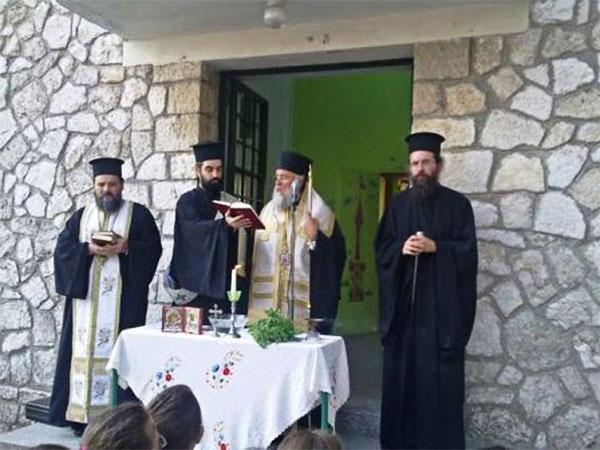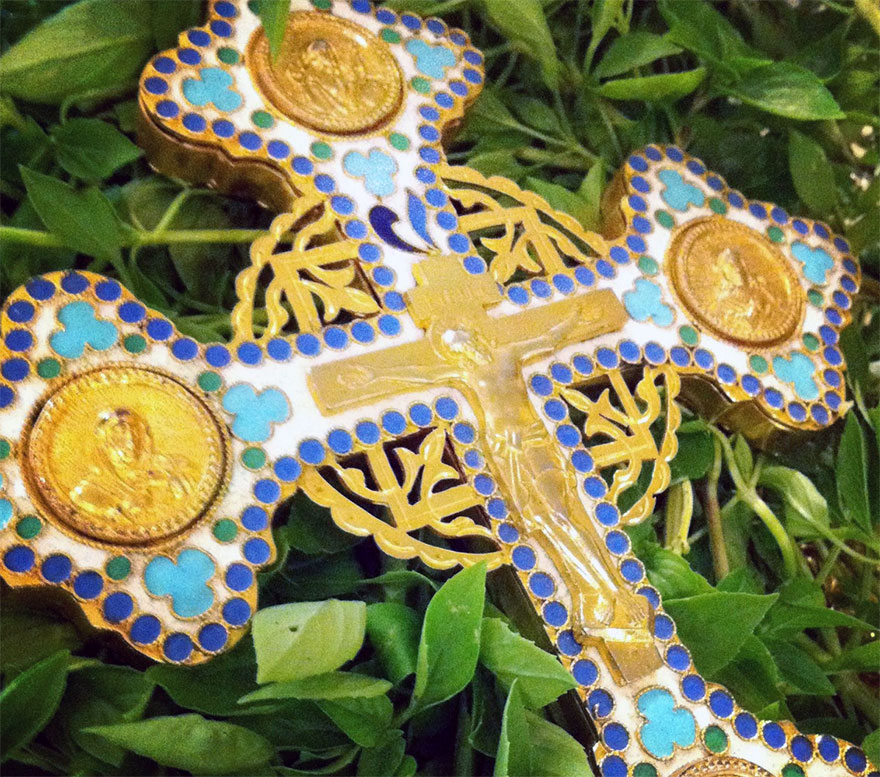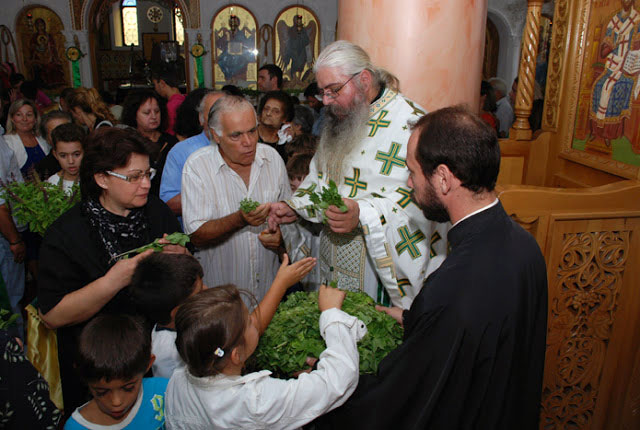Among Vedic practitioners, Tulasi “The Incomparable One”, is vital in the worship of Lord Vishnu. As Vrinda Devi she arranges the pastimes of Sri Sri Radha Krishna in the forests of Vrindavan. Devotees always offer food to the Lord accompanied by a leaf from Tulasi. In addition, Vaishnavas chant on and wear sacred beads made of her wood, and in some traditions anoint their body with sacred clay in the form of her leaf.
For thousands of years Tulasi was worshipped in India and slowly made its way westward via trade routes linking India to Persia and Greece.
Many may not know that Tulasi plays an important role in Orthodox Christianity (including Greek, Bulgarian, Serbian, Macedonian, and Romanian Orthodox Churches). According to Orthodox tradition when the disciples of Jesus went to the tomb of Christ they found it empty but all around the area were fully bloomed Tulasi. The Greeks called Tulasi ‘Holy Basil’, from the Greek word ‘basileus’ meaning King/royalty for it was reserved for the greatest.
Several hundred years later, Helena, the mother of Emperor Constantine, made a pilgrimage to Jerusalem in search of holy relics. It is said she found a barren hill covered in sweet smelling Tulasi, and upon excavation found the true cross beneath the Tulasi plant.
Because Tulasi was discovered both at the cross and tomb of Christ, traditional Orthodox Christians saw it as a symbol of paradise, of spiritual rebirth and sanctity. This sacred plant was cultivated in Orthodox monasteries and became part of the most holy rituals – to create the holy water, to sprinkle the holy water on practitioners, to create the holy oils to anoint, to adorn the altar, and to garland the cross.
This is simply one example of the influence of Vedic culture upon the world.










Other Articles by Vaishnava Das:
Sweet Salt – The Story of How India Invented Sugar
India – The Land of Stolen Jewels
The Vedic People of Scandinavia
Soma – Elixir of the Gods
Manu and the Great Deluge
The Samurai: Protectors of the Cow
The Vedic People of Lithuania
The Legends of Tulasi In Christianity
The Mysterious Iron Deity made from a Meteor
Ancient Shiva Linga in Ireland













Very heart-warming article — thus also shows how the human ‘mind’ wishes to identify itself with “holy” (or rather heart-leasing) articles like Tulsi. Only along the way, the divisions and differences were highlighted to segregate the people –into bottled religions!
Here, in Kerala, churches also have Dhwaja Stambhas, Caprisoned elephants, “Chenda” melam (the drum ensemble), Aksharabhyas during Vijaya Dasami (Saraswati Puja); and Carnatic scores are set for “Christian” songs, and also use Mridangam, Violin etc like any Caranatic Music Programmes. That is the greatness of the all-encompassing heart of our educated state- where people never allow religion to come in their daily life.
Interesting, did not know.
Although Tulsi and Holy Basil are related, they are not exactly the same plant, but are related.
Lord Krishna associated with Tulsi & Jesus Christ associated with Tulsi(Holy Basil) is more than a divine coincidence.There seems to be an undercurrent of divine proximity between Hinduism & Christianity!
This is unbelieveble. Heard about Basil, but I thought that is different from Tulasi though it smells somewhat same. In the above pics, I cannot make outif all are Tulasi leaves but there is one pic ( cross in a small casket with leaves arranged around.) Those leaves surely resemble Tulasi. Thanks anyway for this interesting piece of Information.
Great article with photos…
Brilliant!!
RESPECTED INDIADIVINE .ORG,
GREETINGS
WELCOME YOUR KIND INFORMATIONS
ALL RELIGIONS IS FOR TO ACVHIEVE THE BASIS OF LIFE THATS THE LIBERATION. EVERY FAITH GIVES THE MAN, MENTAL STRENGTH THATS INTURN GIVES HIM EFFORT AND THE EFFORT GIVES HIM THE ACHIEVEMENT TO ATTAIN SUPREME BLISS
ALL RELIGION IS FOR THE HEALTHY MANKIND FOR THAT THE THE HERBS ARE BLESSED BY THE LORD ITS THE GLOBAL RECTIFICATION METHOD FOR ABSOLUTE CURE FROM ALL AILMENTS THIS WHAT I REALIZED FROM YOUR WEBSITE.
I ONCE AGAIN THANKING YOU FOR THE VALUABLE INFORMATIONS
The article definitely invoked our emotions. But from the pics, it does not look like Christians worship actual Tulasi plant. What they might be worshiping is just basil plant. Although Tulasi is from the family of basil plants she is different. Just because Tulasi is from basil family and Christians worship basil plant, does not mean we say that Christians worship the Tulasi plant.
Such logic is very misleading, though good for those who worship Tulasi.
One can search on “Holy Basil” and “Tulasi” or “Tulsi”. Every source will identify them as the same. For instance:
http://en.wikipedia….mum_tenuiflorum
Ocimum tenuiflorum, also known as Ocimum sanctum, holy basil, or tulasī, is an aromatic plant in the family Lamiaceae which is native to the Indian Subcontinent and widespread as a cultivated plant throughout the Southeast Asian tropics.
Thank you for this article! It will be very useful in preaching Krishna consciousness.
this plant is not Tulsi devi, but basil … basil is another plant, is of the same family, but not Tulsi maharani
yes tulasi of India looks different due to different soil & climate. That’s obvious right. Also, It does not grow in many western countries due to extreme climate.
If we look into materialistic life – all religions are related. But Vedas are the only knowledge which explain about BODY , MIND and SOUL – GENERATE, ORGANISE AND DESTRUCTION ( CREATE, SUSTAIN AND DESTROY)
tulsi or basil appears to be in all human religion
I’s like to add that from my personal experience, because I live in a predominatly Orthodox Christian country, tulasi or basil of any kind is not worshipped as say a shiv lingam is worshipped. Christianity, Judaism and Islam do not allow the worship of anything else but God. The world is seen separate from God. While for the Hindu mind and religious thought this does not make sense, this is the case with all three monotheistic traditions. No objects are worshipped because that would mean God is of the same or of similar essence to the world and matter.
However objects can be honored in the sense of representing a holy person or as tools of ritual communion with God for exapmle sprinking with holy water. But this is never seen as worship, objects have a honorific or ritual role and that’s it.
Hopefully that sheds a bit of light here.
Also yes it’s impressive how basil is ritually used as a tool of bringing the grace of God upon the believers in so many faiths. Truly impressive.